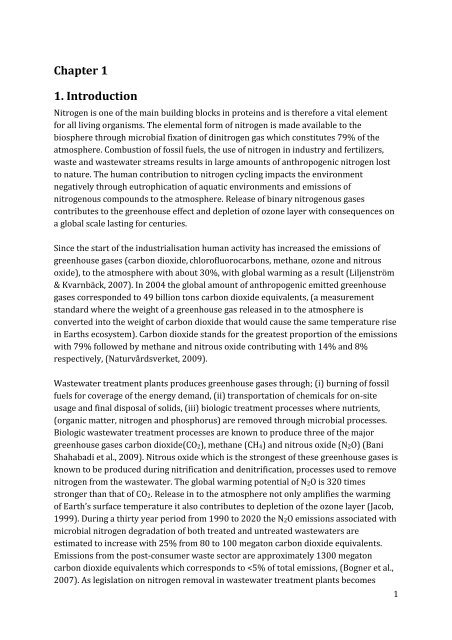N2O production in a single stage nitritation/anammox MBBR process
N2O production in a single stage nitritation/anammox MBBR process
N2O production in a single stage nitritation/anammox MBBR process
You also want an ePaper? Increase the reach of your titles
YUMPU automatically turns print PDFs into web optimized ePapers that Google loves.
Chapter 1<br />
1. Introduction<br />
Nitrogen is one of the ma<strong>in</strong> build<strong>in</strong>g blocks <strong>in</strong> prote<strong>in</strong>s and is therefore a vital element<br />
for all liv<strong>in</strong>g organisms. The elemental form of nitrogen is made available to the<br />
biosphere through microbial fixation of d<strong>in</strong>itrogen gas which constitutes 79% of the<br />
atmosphere. Combustion of fossil fuels, the use of nitrogen <strong>in</strong> <strong>in</strong>dustry and fertilizers,<br />
waste and wastewater streams results <strong>in</strong> large amounts of anthropogenic nitrogen lost<br />
to nature. The human contribution to nitrogen cycl<strong>in</strong>g impacts the environment<br />
negatively through eutrophication of aquatic environments and emissions of<br />
nitrogenous compounds to the atmosphere. Release of b<strong>in</strong>ary nitrogenous gases<br />
contributes to the greenhouse effect and depletion of ozone layer with consequences on<br />
a global scale last<strong>in</strong>g for centuries.<br />
S<strong>in</strong>ce the start of the <strong>in</strong>dustrialisation human activity has <strong>in</strong>creased the emissions of<br />
greenhouse gases (carbon dioxide, chlorofluorocarbons, methane, ozone and nitrous<br />
oxide), to the atmosphere with about 30%, with global warm<strong>in</strong>g as a result (Liljenström<br />
& Kvarnbäck, 2007). In 2004 the global amount of anthropogenic emitted greenhouse<br />
gases corresponded to 49 billion tons carbon dioxide equivalents, (a measurement<br />
standard where the weight of a greenhouse gas released <strong>in</strong> to the atmosphere is<br />
converted <strong>in</strong>to the weight of carbon dioxide that would cause the same temperature rise<br />
<strong>in</strong> Earths ecosystem). Carbon dioxide stands for the greatest proportion of the emissions<br />
with 79% followed by methane and nitrous oxide contribut<strong>in</strong>g with 14% and 8%<br />
respectively, (Naturvårdsverket, 2009).<br />
Wastewater treatment plants produces greenhouse gases through; (i) burn<strong>in</strong>g of fossil<br />
fuels for coverage of the energy demand, (ii) transportation of chemicals for on-site<br />
usage and f<strong>in</strong>al disposal of solids, (iii) biologic treatment <strong>process</strong>es where nutrients,<br />
(organic matter, nitrogen and phosphorus) are removed through microbial <strong>process</strong>es.<br />
Biologic wastewater treatment <strong>process</strong>es are known to produce three of the major<br />
greenhouse gases carbon dioxide(CO2), methane (CH4) and nitrous oxide (<strong>N2O</strong>) (Bani<br />
Shahabadi et al., 2009). Nitrous oxide which is the strongest of these greenhouse gases is<br />
known to be produced dur<strong>in</strong>g nitrification and denitrification, <strong>process</strong>es used to remove<br />
nitrogen from the wastewater. The global warm<strong>in</strong>g potential of <strong>N2O</strong> is 320 times<br />
stronger than that of CO2. Release <strong>in</strong> to the atmosphere not only amplifies the warm<strong>in</strong>g<br />
of Earth’s surface temperature it also contributes to depletion of the ozone layer (Jacob,<br />
1999). Dur<strong>in</strong>g a thirty year period from 1990 to 2020 the <strong>N2O</strong> emissions associated with<br />
microbial nitrogen degradation of both treated and untreated wastewaters are<br />
estimated to <strong>in</strong>crease with 25% from 80 to 100 megaton carbon dioxide equivalents.<br />
Emissions from the post-consumer waste sector are approximately 1300 megaton<br />
carbon dioxide equivalents which corresponds to















